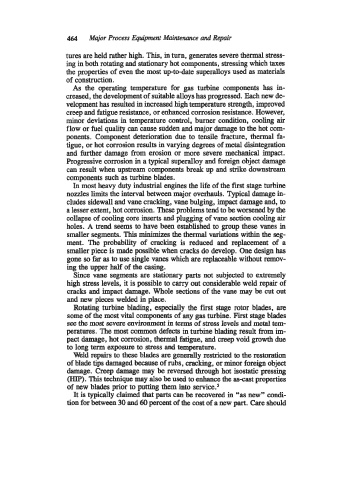Page 487 - Practical Machinery Management for Process Plants Major Process Equipment Maintenance and Repair
P. 487
464 Major Process Equipment Maintenance and Repair
tures are held rather high. This, in turn, generates severe thermal stress-
ing in both rotating and stationary hot components, stressing which taxes
the properties of even the most up-to-date superalloys used as materials
of construction.
As the operating temperature for gas turbine components has in-
creased, the development of suitable alloys has progressed. Each new de-
velopment has resulted in increased high temperature strength, improved
creep and fatigue resistance, or enhanced corrosion resistance. However,
minor deviations in temperature control, burner condition, cooling air
flow or fuel quality can cause sudden and major damage to the hot com-
ponents. Component deterioration due to tensile fracture, thermal fa-
tigue, or hot corrosion results in varying degrees of metal disintegration
and further damage from erosion or more severe mechanical impact.
Progressive corrosion in a typical superalloy and foreign object damage
can result when upstream components break up and strike downstream
components such as turbine blades.
In most heavy duty industrial engines the life of the first stage turbine
nozzles limits the interval between major overhauls. Typical damage in-
cludes sidewall and vane cracking, vane bulging, impact damage and, to
a lesser extent, hot corrosion. These problems tend to be worsened by the
collapse of cooling core inserts and plugging of vane section cooling air
holes. A trend seems to have been established to group these vanes in
smaller segments. This minimizes the thermal variations within the seg-
ment. The probability of cracking is reduced and replacement of a
smaller piece is made possible when cracks do develop. One design has
gone so far as to use single vanes which are replaceable without remov-
ing the upper half of the casing.
Since vane segments are stationary parts not subjected to extremely
high stress levels, it is possible to carry out considerable weld repair of
cracks and impact damage. Whole sections of the vane may be cut out
and new pieces welded in place.
Rotating turbine blading, especially the first stage rotor blades, are
some of the most vital components of any gas turbine. First stage blades
see the most severe environment in terms of stress levels and metal tem-
peratures. The most common defects in turbine blading result from im-
pact damage, hot corrosion, thermal fatigue, and creep void growth due
to long term exposure to stress and temperature.
Weld repairs to these blades are generally restricted to the restoration
of blade tips damaged because of rubs, cracking, or minor foreign object
damage. Creep damage may be reversed through hot isostatic pressing
This
m). technique may also be used to enhance the ascast properties
of new blades prior to putting them into ~ervice.~
It is typically claimed that parts can be recovered in “as new” condi-
tion for between 30 and 60 percent of the cost of a new part. Care should

